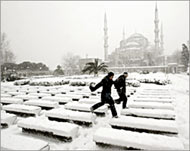Ship risk worsens in Bosphorus
Stretching 30km between the Black Sea and the Marmara, the Bosphorus strait is one of the few places in the world where residents face being hit by a supertanker in their front rooms.

The busy shipping route links two continents, while splitting the Turkish capital, Istanbul, in half. Picturesque homes flank the shores, but according to the Turkish Pilots Association, most years see at least half a dozen ships colliding into houses.
“Sometimes they seem to come so close and the ships are so big you can’t help worrying,” says Ayse Erduran, a resident of the suburb of Bebek, where the Bosphorus reaches its narrowest point, at only 700m wide. Her wooden Ottoman-era house perches on the water’s edge.
And many of these ships have been carrying potentially lethal cargoes.
“If an accident happens and oil leaks,” Baris Tozar, Istanbul’s Shore Security and Shipwreck Management general manager, told Aljazeera.net, “a spark might ignite it and turn it into lava, which floats across the surface of the water. With the four to five knot speed of the Bosphorus current, this burning oil will flow along, setting fire to everything on the shores.”
It is a danger that many of the city’s 12million residents – and the Turkish government – want to see an end to.
Overcrowded waters
In 2002, the last full year for official records, some 47,283 ships, 6022 of them carrying potentially dangerous oil and petrochemical cargoes, cruised through the Bosphorus.
Most of these vessels are in transit between the oil and gas terminals on the Black Sea shores and African countries and the west. Caucasian and Central Asian oil, along with petrochemicals, made up 122 million tons of product passing along the strait in 2002.
As the Bosphorus – and the Dardanelles, further south at the entrance to the Aegean Sea – are international waters, Turkey has no power to enforce special safety standards on the ships passing through.
“We see the danger in the straits and demand vessels take on a pilot and a tugboat, but everyone else is waiting for a disaster to get action,” says Tozer.
“With its 12 sharp turns,” he continues, “the Bosphorus is one of the most dangerous straits in the world.”
Dangerous currents
The strait has four currents and many whirlpools in its bays. Adding to the dangers are the winds, with the southerly “lodos” wind, long feared by sailors for its strength, which can reach up to a gale force strength and even reverse the surface current.
“The current, which is normally five to six knots,” says Tozer, “can go up to six or seven and can cause ships to lose control, like a car on ice. The Bosphorus’ narrowest point is 700m, with an average of 1400m, making it very narrow. Tankers can miss their turning point and the wind can push the ship up against the shore.”
 |
|
Istanbul was hit by heavy snow |
If the weather is particularly bad, the Turkish authorities have the power to close the straits. Last week saw just such an event, when snow blizzards forced closure and created a queue of 68 tankers at the Dardanelles.
Likewise, if a supertanker is passing, they can close the channel to all other traffic while the giant lumbers through.
Early January, for example, showed the strait closed for three and a half hours while the 54m AMT Explorer passed through under tow.
Closure allegations
Yet these closures have recently led to protests from tanker owners and European refineries, with the allegation being made that Turkey is unnecessarily closing the strait.
Mid-January saw delays in passage through the straits that forced refiners to look elsewhere for supplies. Ship owners – and the Russian government – warned that 12- to 14-day delays should be expected, creating a situation one oil industry insider, who wished to remain anonymous, described as “something not seen since the Gulf War of 1991”.
The suspicion is that the closures were not due to bad weather or large ships, but due to Turkey’s desire to reduce tanker traffic overall in the straits.
“Turkey has long been pushing for overland pipeline routes for Caucasian and Central Asian oil and gas,” comments Nuri Alpay, an Istanbul-based oil sector analyst. “The overland route gives Turkey receipts from transit, as the pipelines would all cross Turkish territory.
|
“The Bosphorus and Dardanelles are being used for transport which is dangerous but unprofitable” Baris Tozar, |
“At the moment, the Bosphorus and Dardanelles are being used for transport, which is not only dangerous but unprofitable, as the ships don’t pay anything to transit international waters.”
Yet Turkish authorities deny any such motives. “Ninety-nine point nine per cent of the closures are just due to bad weather,” says Tozer.
The country’s authorities have, however, long lobbied for pipeline routes – and in particular, the Baku-Ceyhan pipeline, which will take Caspian oil from the Azeri capital of Baku to the Turkish Mediterranean port of Ceyhan when it is finished.
“In 2003, more than 140million tons of oil passed through the straits,” says Cahit Istiklal, an associate manager at the World Pilots Association. “If you talk about pipelines, then the Baku-Ceyhan pipeline [which will run across Turkish territory] carries about 50 million tonnes a year. In other words, the straits are equivalent to nearly three Baku-Ceyhan pipelines.”
As traffic was returning to normal this week, residents of the straits, including Erduran, were busy repairing damage caused by the blizzards. “At least when the strait is closed for bad weather, we don’t have to worry about the ships,” says Erduran.